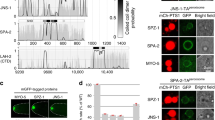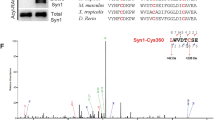Abstract
Septins are GTPases required for the completion of cytokinesis in diverse organisms, yet their roles in cytokinesis or other cellular processes remain unknown. Here we describe studies of a newly identified septin, CDCrel-1, which is predominantly expressed in the nervous system. This protein was associated with membrane fractions, and a significant fraction of the protein copurified and coprecipitated with synaptic vesicles. In detergent extracts, CDCrel-1 and another septin, Nedd5, immunoprecipitated with the SNARE protein syntaxin by directly binding to syntaxin via the SNARE interaction domain. Transfection of HIT-T15 cells with wild-type CDCrel-1 inhibited secretion, whereas GTPase dominant-negative mutants enhanced secretion. These data suggest that septins may regulate vesicle dynamics through interactions with syntaxin.
This is a preview of subscription content, access via your institution
Access options
Subscribe to this journal
Receive 12 print issues and online access
$209.00 per year
only $17.42 per issue
Buy this article
- Purchase on Springer Link
- Instant access to full article PDF
Prices may be subject to local taxes which are calculated during checkout






Similar content being viewed by others
References
Rothman, J. & Warren, G. Implications of the SNARE hypothesis for intracellular membrane topology and dynamics. Curr. Biol. 4, 220–233 (1994).
Hanson, P., Heuser, J. & Jahn, R. Neurotransmitter release - four years of SNARE complexes. Curr. Opin. Neurobiol. 7, 310– 315 (1997).
Weis, W. & Scheller, R. SNARE the rod, coil the complex. Nature 395, 328–329 (1998).
Sutton, R., Fasshauer, D., Jahn, R. & Brunger, A. Crystal structure of a SNARE complex involved in synaptic exocytosis at 2.4 Å resolution. Nature 395, 347–353 (1998).
Weber, T. et al. SNAREpins: minimal machinery for membrane fusion. Cell 92, 759–772 ( 1998).
Otto, H., Hanson, P. & Jahn, R. Assembly and disassembly of a ternary complex of synaptobrevin, syntaxin, and SNAP-25 in the membrane of synaptic vesicles. Proc. Natl. Acad. Sci. USA 94, 6197–6201 (1997).
Honer, W., Hu, L. & Davies, P. Human synaptic proteins with a heterogeneous distribution in cerebellum and visual cortex. Brain Res. 609, 9– 20 (1993).
Honer, W. et al. Cingulate cortex synaptic terminal proteins and neural cell adhesion molecule in schizophrenia. Neuroscience 78, 99–110 (1997).
Caltagarone, J., Rhodes, J., Honer, W. & Bowser, R. Localization of a novel septin protein, hCDCrel-1, in neurons of the human brain. Neuroreport 9, 2907–2912 (1998).
Hartwell, L. Genetic control of the cell division cycle in yeast. IV. Genes controlling bud emergence and cytokinesis. Exp. Cell Res. 69, 265–276 (1971).
Byers, B. & Goetsch, L. Loss of the filamentous ring in cytokinesis-defective mutants of budding yeast. J. Cell Biol. 70, 35 (1976).
Haarer, B. K. & Pringle, J. R. Immunofluorescence localization of the Saccharomyces cerevisiae CDC12 gene product to the vicinity of the 10-nm filaments in the mother-bud neck. Mol. Cell. Biol. 7, 3678–3687 (1987).
Kim, H. B., Haarer, B. K. & Pringle, J. R. Cellular morphogenesis in the Saccharomyces cerevisiae cell cycle: localization of the CDC3 gene product and the timing of events at the budding site. J. Cell Biol. 112, 535–544 (1991).
Ford, S. K. & Pringle, J. R. Cellular morphogenesis in the Saccharomyces cerevisiae cell cycle: localization of the CDC11 gene product and the timing of events at the budding site. Devel. Genet. 12, 281–292 (1991).
Sanders, S. L. & Field, C. M. Septins in common? Curr. Biol. 4, 907–910 (1994).
Longtine, M. S. et al. The septins: roles in cytokinesis and other processes. Curr. Opin. Cell Biol. 8, 106–119 (1996).
Neufeld, T. P. & Rubin, G. M. The Drosophila peanut gene is required for cytokinesis and encodes a protein similar to yeast putative bud neck filament proteins. Cell 77, 371–379 (1994).
Fares, H., Peifer, M. & Pringle, J. R. Localization and possible functions of Drosophila septins. Mol. Biol. Cell 6, 1843– 1859 (1995).
Field, C. M. et al. A purified Drosophila septin complex forms filaments and exhibits GTPase activity. J. Cell Biol. 133, 605– 616 (1996).
Kumar, S., Tomooka, Y. & Noda, M. Identification of a set of genes with developmentally down-regulated expression in the mouse brain. Biochem. Biophys. Res. Comm. 185, 1155–1161 (1992).
Kinoshita, M. et al. Nedd5, a mammalian septin, is a novel cytoskeletal component interacting with actin-based structures. Genes Devel. 11, 1535–1547 (1997).
Zieger, B., Hashimoto, Y. & Ware, J. Alternative expression of platelet glycoprotein Ibbeta mRNA from an adjacent 5´ gene with an imperfect polyadenylation signal sequence. J. Clin. Invest. 99, 520– 525 (1997).
McKie, J. M., Sutherland, H. F., Harvey, E., Kim, U.-J. & Scambler, P. J. A human gene similar to Drosophila melanogaster peanut maps to the DiGeorge syndrome region of 22q11. Hum. Genet. 101, 6–12 ( 1997).
Xie, H., Howard, J., Surka, M. & Trimble, W. Characterization of the mammalian septin H5: Distinct properties of cytoskeletal and membrane association from other mammalian septins. Cell Motil. Cytoskel. (in press).
Huttner, W., Schiebler, W., Greengard, P. & De Camilli, P. Synapsin I (protein I), a nerve terminal-specific phosphoprotein. III. Its association with synaptic vesicles studied in a highly purified synaptic vesicle preparation. J. Cell Biol. 96, 1374– 1388 (1983).
Wheeler, M. et al. Characterization of SNARE protein expression in beta cell lines and pancreatic islets. Endocrinology 137, 1340–1348 (1996).
Schiavo, G. et al. Tetanus and botulinum-B neurotoxins block neurotransmitter release by proteolytic cleavage of synaptobrevin. Nature 359, 832–835 (1992).
Walch-Solimena, C. et al. The t-SNAREs syntaxin 1 and SNAP-25 are present on organelles that participate in synaptic vesicle recycling. J. Cell Biol. 128, 637–645 (1995).
Hsu, S.-C. et al. Subunit composition, protein interactions and structures of the mammalian brain sec6/8 complex and septin filaments. Neuron 20, 1111–1122 ( 1998).
Bowser, R., Muller, H., Govindan, B. & Novick, P. Sec8p and Sec15p are components of a plasma membrane-associated 19.5S particle that may function downstream of Sec4p to control exocytosis. J. Cell Biol. 118, 1041–1056 (1992).
Hsu, S. et al. The mammalian brain rsec6/8 complex. Neuron 17, 1209–1219 (1996).
Landis, D., Hall, A., Weinstein, L. & Reese, T. The organization of cytoplasm at the presynaptic active zone of a central nervous system synapse. Neuron 1, 201–209 (1988).
Hirokawa, N., Sobue, K., Kanda, K., Harada, A. & Yorifuji, H. The cytoskeletal architecture of the presynaptic terminal and molecular structure of synapsin 1. J. Cell Biol. 108, 111–126 (1989).
Chandler, D. & Heuser, J. Arrest of membrane fusion events in mast cells by quick-freezing. J. Cell Biol. 86, 666–674 (1980).
Monck, J. & Fernandez, J. The exocytic fusion pore and neurotransmitter release. Neuron 12, 707– 716 (1994).
Burgess, R., Deitcher, D. & Schwarz, T. The synaptic protein syntaxin1 is required for cellularization of Drosophila embryos. J. Cell Biol. 138, 861–875 (1997).
Byers, B. in The Molecular Biology of the Yeast Saccharomyces, Life Cycle and Inheritance (eds. Strathern, J., Jones, E. & Broach, J.) 59– 96 (Cold Spring Harbor Lab Press, Cold Spring Harbor, New York, 1981).
Gaisano, H. et al. Distinct cellular locations of the syntaxin family of proteins in rat pancreatic acinar cells. Mol. Biol. Cell 7, 2019–2027 (1996).
Gaisano, H. Y., Sheu, L., Foskett, J. K. & Trimble, W. S. Tetanus toxin light chain cleaves a vesicle-associated membrane protein (VAMP) isoform-2 in rat pancreatic zymogen granules and inhibits enzyme secretion. J. Biol. Chem. 269, 17062–17066 (1994).
Huang, X. et al. Truncated SNAP-25, like botulinum neurotoxin A, inhibits insulin secretion from HIT-T15 cells. Mol. Endocrinol. 12, 1060–1070 (1998).
Acknowledgements
The authors thank G. Boulianne for comments on the manuscript. This work was supported by grant MT-13465 from the Medical Research Council of Canada to WST and NIH grant AG13208 to RB.
Author information
Authors and Affiliations
Corresponding author
Rights and permissions
About this article
Cite this article
Beites, C., Xie, H., Bowser, R. et al. The septin CDCrel-1 binds syntaxin and inhibits exocytosis. Nat Neurosci 2, 434–439 (1999). https://doi.org/10.1038/8100
Received:
Accepted:
Issue Date:
DOI: https://doi.org/10.1038/8100
This article is cited by
-
Neuronal-specific septin-3 binds Atg8/LC3B, accumulates and localizes to autophagosomes during induced autophagy
Cellular and Molecular Life Sciences (2022)
-
Biochemical and morphological characterization of SEPT1 in mouse brain
Medical Molecular Morphology (2020)
-
Synaptic mitochondrial dysfunction and septin accumulation are linked to complement-mediated synapse loss in an Alzheimer’s disease animal model
Cellular and Molecular Life Sciences (2020)
-
In the line-up: deleted genes associated with DiGeorge/22q11.2 deletion syndrome: are they all suspects?
Journal of Neurodevelopmental Disorders (2019)
-
Underpinning heterogeneity in synaptic transmission by presynaptic ensembles of distinct morphological modules
Nature Communications (2019)



